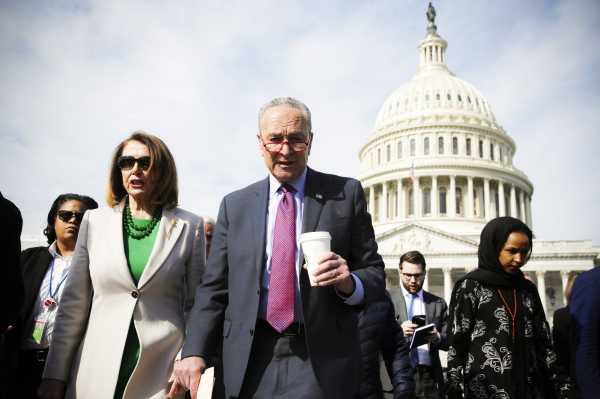
Democrats’ extremely uphill battle to retake the Senate majority in 2020, explained
Senate Democrats are technically on offense in 2020, but they’re still dealing with a very tough map.
By
Tara Golshan and Ella Nilsen
Updated
Jul 9, 2019, 3:03pm EDT
Share
Tweet
Share
Share
Democrats’ extremely uphill battle to retake the Senate majority in 2020, explained
tweet
share
The No. 1 item on the agenda for Democrats in 2020 is defeating Donald Trump. But the Democratic agenda hinges on retaking the Senate. And that could be an uphill battle.
Senate Republicans hold a three-seat majority and will have to defend 22 seats in 2020. Democrats, meanwhile, are up in just 12 states. But the map still doesn’t look good for them.
“What makes this map very deceiving was in 2018, Democrats had to defend five seats in states Trump won by 19 points or more,” said Jennifer Duffy, a Senate expert at the nonpartisan Cook Political Report. “In this case, there’s no Republican sitting in a state that Clinton won by more than 5.”
Just three Republican seats seem truly competitive, as far as the Cook Political Report is concerned: Colorado, Arizona, and Maine. The rest is a sea of red, including the seat Democrats have to defend in ultraconservative Alabama.
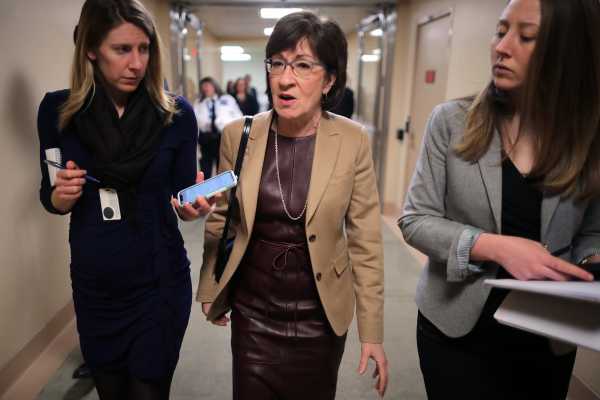
Compounding Democrats’ problems is a group of high-profile potential Senate candidates opting to run for president or just sit the whole thing out. Herein lies the central contradiction in 2020 politics: Democrats are telling voters the election — up and down the ballot — is of grave consequence. But undermining that push is the tacit belief that the Senate, and the party’s power in it, is a shadow of what it once was.
“If people thought it mattered that Democrats controlled the Senate, then they would run to be a Democrat in the Senate,” said James Wallner, a political scientist with the conservative think tank R Street.
That said, even if Democrats manage to retake the White House, a Senate majority stands between them and the ability to pursue any real legislative agenda and, crucially, the ability to confirm nominees to the Supreme Court and other important positions. Without the Senate, Democrats’ ideas will remain pipe dreams.
Democrats are facing a serious uphill battle to retaking the Senate
To retake a bare majority in the Senate, Democrats need to pick up four seats on net. Because this cohort of senators was last up for election in 2014 — a very strong year for Republicans — Democrats are on offense this year.
Democrats do have certain factors playing in their favor. They hope Trump’s low approval rating could ride some of their candidates to victory. After all, Trump is polling on net at -13 in Colorado, -15 in Maine, and -7 in Arizona — the places where Democrats have their best shots — according to Morning Consult. Even in reddish states like Iowa, the president’s trade war with China could make Sen. Joni Ernst, who is in her first reelection race in the state, vulnerable. Even historically red states like Kansas, where there is an open Senate seat, could give Democrats hope. After all, distaste for Trump-like Republicans landed a Democrat in the Kansas governor’s office last year.
But the path is tenuous. To retake the majority, Democrats would likely have to:
1) Keep Sen. Doug Jones’s seat in deep-red Alabama. (Trump has a +27 approval rating there.)
2) Win Arizona and Colorado — and they could, since there are already strong candidates declared or interested in running.
3) Turn out an extremely enthusiastic Democratic base and put tough states — Maine, Georgia, Texas, Montana, and Iowa — within reach. Democrats, by the way, still need to recruit “top tier” candidates in all of these states.
4) Take advantage of divisive Republican primaries in Kansas and North Carolina, where Trump has anemic approval ratings. But again, they need solid candidates to compete.
With a bare majority, Democrats will at least be able to confirm key Cabinet appointments and judicial nominees, and pass some budget measures. As long as the filibuster is intact, they would still need Republicans to agree on some of their policy proposals — though a bare majority could decide to change the rules and eliminate the filibuster altogether, something a few presidential candidates including Sen. Elizabeth Warren (D-MA) have already endorsed.
“2020 is about the White House, but it’s also about the United States Senate,” presidential candidate Sen. Kamala Harris (D-CA) told the audience at an MSNBC town hall in South Carolina on Wednesday. She’s right.
Democrats got a sense of Republican vulnerabilities in 2018 in Colorado, Arizona, and Maine
Last year’s wave election for Democrats is giving them some hope. First and foremost, they had easy statewide wins in states like Colorado, where Republican Cory Gardner is up for reelection in 2020.
Colorado is by far Democrats’ most promising target. Gardner is running for his second term in the Senate in a state where just last year, Democrats easily kept the governor’s mansion and won total control of the state’s legislature. The demographics are shaping up for Democrats in Colorado; the Latinx population has changed the political tide in the state, as have young voters, and Trump’s popularity in Colorado has tanked ever since he took office.
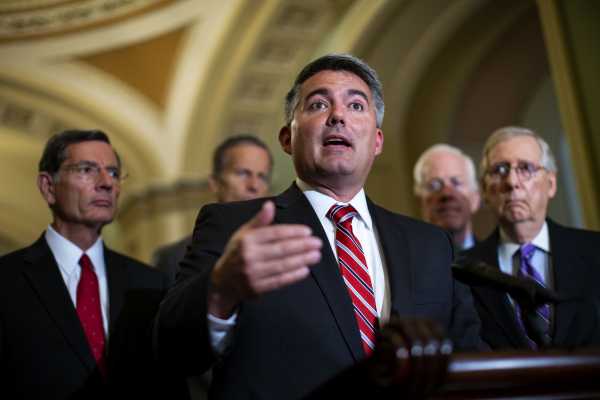
Gardner has done little to distance himself from the president. He’s cemented his reputation as a party man, successfully chairing the National Senate Republican Committee, the official campaign arm for Senate Republicans, and growing the Republican majority in the Senate. He’s also endorsed Trump, and even flipped to support things like the president’s national emergency for the border wall.
Former Colorado Gov. John Hickenlooper would be a logical top-tier candidate to face Gardner (he won statewide when Gardner came into power in 2014, a Republican wave election), but he chose instead to run for president. Instead, a long list of lesser-known Democrats have jumped in to fill that vacuum, from former state Sen. Mike Johnston — who unsuccessfully ran in the primary for governor last year — to former state House Speaker Andrew Romanoff, former Obama administration official Dan Baer, and former US Attorney John Walsh.
Democrats also have hope in Arizona, where Kyrsten Sinema beat out Republican Martha McSally in a state that voted for Trump in 2016 and has a strong conservative base. Sinema outperformed polling, which showed McSally with a slight lead.

In an interesting twist, McSally is up for reelection this year, after she was appointed to serve out part of Sen. John McCain’s remaining term after his death. Arizona Republicans have to prove that their losing candidate is actually a winner. McSally is a well-known entity in Arizona, after Republicans pulled out all the stops for her. But even with high name recognition, she’s still not that popular.
Democrats look ready and organized: They have already cleared the field for Mark Kelly, a retired astronaut, military veteran, and gun control advocate. He’s the husband of former Arizona Rep. Gabby Giffords, who was shot in 2011 at a local event in Tucson. Together, they run the group Americans for Responsible Solutions, a nonprofit and Super PAC dedicated to preventing gun violence. Kelly has been raising more money than McSally, and despite being lesser-known is well liked.
Then there’s Maine, which in theory should be a good target for Democrats. It’s one of the few states with a Republican-held seat that Hillary Clinton won in 2016. Trump’s approval rating there is 41 percent, but Sen. Susan Collins is a more moderate Republican who has sailed to victory numerous times. That said, her decision to vote for Supreme Court Justice Brett Kavanaugh after he was accused of past sexual assault in the middle of his confirmation process has garnered backlash in the state — particularly with threats to Roe v. Wade making their way to the Supreme Court. Collins’s approval rating is around 52 percent (with 39 percent disapproving), per Morning Consult. However, a recent Maine-based poll, Critical Insights, showed her approval rating at just 41 percent (with 42 percent disapproval), a dramatic decline since last spring.
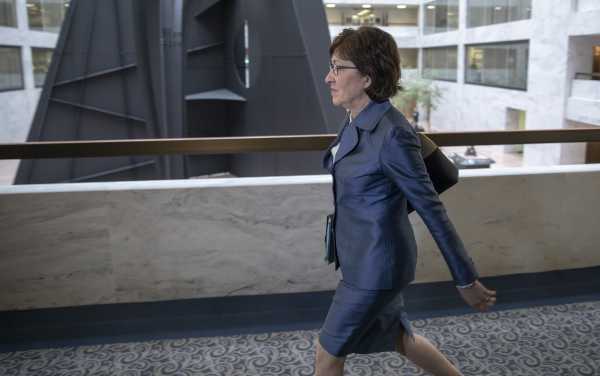
The most well-known Democratic candidate in Maine is current Maine House Speaker Sara Gideon, who went toe to toe with former conservative Gov. Paul LePage, and recently announced her campaign for Senate. Any Democrat running in Maine will have to do well with independents, including those in the state’s rural, more conservative Second Congressional District. Democratic Rep. Jared Golden now represents that area, but he’s unlikely to pursue the Senate seat.
So in two of the three best targets, Democrats’ chances look fair to good, but other races are looking tougher — at least so far.
Democrats need to defend Alabama; North Carolina and Kansas are possible reaches
The rest of the Senate races will be an uphill battle for Democrats.
First, they’ll have to defend Sen. Doug Jones’s seat in Alabama. Rep. Bradley Byrne, a top Republican recruit, is running. Roy Moore, the controversial Republican whom Jones defeated in 2017 after he was accused of sexual misconduct against multiple minors, formally announced another campaign. If Moore somehow gets the nomination again, Democrats might be in better shape, but the dynamics will still be tough. One of the theories of why Jones won in the first place is that special elections are lower-turnout affairs, and if you have a highly motivated base, you can swing them.
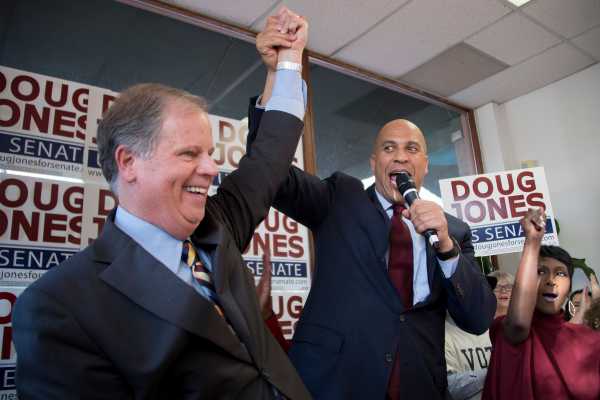
To win the Senate majority, though, Democrats must be competitive in states like Georgia, North Carolina, Iowa, Kansas, Texas, or Tennessee, where they’ve seen statewide losses in the Trump era.
North Carolina Democrats saw a rare 2016 victory when Gov. Roy Cooper won the state, along with Trump. Now Republican Sen. Thom Tillis is in a tough race, starting with the GOP primary. Tillis has been dogged by attacks from conservatives questioning his allegiance to the president after he spearheaded an effort to shield special counsel Robert Mueller from Trump’s interference.
He has already attracted a primary challenger, retired business executive Garland Tucker III, whom Tillis seems to be taking seriously. Democrats will be watching the outcome of the primary closely. The Democrats in the race; state Sen. Erica Smith has announced, along with Trevor Fuller, a former county commissioner chair, Durham businessman Steven Williams and veteran and former state lawmaker Cal Cunningham, who ran for Senate in 2010 and lost.
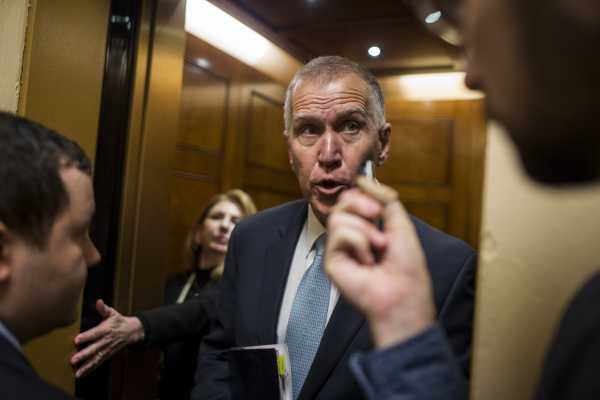
There are other glimmers of hope for Democrats across the country.
In Kansas, there’s an open seat to chase with the retirement of longtime Sen. Pat Roberts, which could trigger a large field of candidates vying to replace him. There are no declared Democrats yet, but Kansas Democrats have a reason to be optimistic for the first time in years.
The 2018 midterms were excellent for them; Democrat Laura Kelly beat controversial former Kansas secretary of state and Trump ally Kris Kobach, and Democrats flipped a key congressional seat with Rep. Sharice Davids, an openly gay Native American woman. Democrats were gleeful when Kobach launched his Senate bid, and National Republican Senatorial Committee put out a statement blasting his candidacy.
“Just last year Kris Kobach ran and lost to a Democrat,” NRSC spokeswoman Joanna Rodriguez said in a statement to the Washington Post. “Now, he wants to do the same and simultaneously put President Trump’s presidency and Senate majority at risk. We know Kansans won’t let that happen and we look forward to watching the Republican candidate they do choose win next fall.”
On the Democratic side, former U.S. Attorney Barry Grissom and former Kansas congresswoman Nancy Boyda have both announced they’re running for Senate.
The rest of the map looks nearly impossible for Democrats
After that, Democrats’ only real chances lie in rapidly accelerating trends in the Sun Belt — diversifying Southern states where Trump is less popular. It’s something they might even be able to pull off if they had superstar candidates, but they’ve already had to weather a few rejections.
Stacey Abrams dashed the hopes of national Democrats when she declared she wouldn’t run for Georgia’s Senate seat in 2020. Trump ally and immigration hardliner Sen. David Perdue is up for reelection, and Abrams — a black woman and breakout star who narrowly lost the governor’s race in 2018 — was seen as the best shot to challenge him. Columbus, Georgia, Mayor Teresa Tomlinson is running. Other names rumored to be in contention are Sarah Riggs Amico, who ran for lieutenant governor last year, and Jon Ossoff, who lost a special election against now-unseated Karen Handel in a 2017 congressional race.

In Texas, Beto O’Rourke made Democrats believe winning statewide was possible when he lost to incumbent Sen. Ted Cruz by just 2 points in 2018. But now he’s running for president — along with 23 other people. So is Julián Castro, the former Obama Cabinet official long talked about as the man who could bring a blue wave to Texas. In their place, Texas Democrats are banking on M.J. Hegar, a woman Air Force veteran who narrowly lost in 2018. She’s running to oust Sen. John Cornyn, who’s less popular in the state than Cruz. Chris Bell, a former Houston congressman and 2006 gubernatorial candidate is also running. Sema Hernandez, a Houston activist who ran in the primary against O’Rourke last year is also in the race.
In Montana, Democratic recruitment is facing an even steeper hurdle after Democratic term-limited Gov. Steve Bullock announced he is running for president. Bullock is the most popular statewide official in Montana, which makes him a natural pick to take on Sen. Steve Daines. Helena Mayor Wilmot Collins — the state’s first black mayor — has already announced his candidacy, but he’s a relative unknown compared to Bullock.
Democrats theoretically have opportunities in Iowa; they managed to flip two conservative congressional seats there in 2018, and Joni Ernst’s Senate term is up. Des Moines business leader and Democrat Theresa Greenfield announced she will challenge Ernst, as has attorney Kimberly Graham and Eddie Mauro, who lost the Democratic primary to Rep. Cindy Axne last year. There’s also Tennessee, where Sen. Lamar Alexander is retiring, leaving an open seat. The state, however, was a major point of disappointment for Democrats in 2018; their best recruit, popular former Gov. Phil Bredesen, lost an open Senate seat to Republican Marsha Blackburn. Democrat attorney and Iraq war veteran James Mackler has announced he’s running.
Lastly, Senate Majority Leader Mitch McConnell has officially gotten a Democratic challenger for his re-election race in Kentucky. Retired Lt. Col. Amy McGrath, the Marine Corps veteran and fighter pilot who ran and lost her race as a Democrat for Kentucky’s Sixth Congressional District in 2018, announced she running for Senate.
McGrath’s bid will be an extremely uphill battle; even though McConnell has low approval ratings, Trump is extremely popular in the state, and McConnell has a lot of money to spend on getting re-elected. Kentucky isn’t really on Senate Democrats’ offensive map, but the fight in the state could energize Democrats in other races — as long as it doesn’t divert too much fundraising McGrath’s way, away from more competitive races.
Democrats really want to win, but they lack incentives to offer premium candidates to run for the Senate
Democrats will have to play big in 2020 to make serious gains in the Senate; they’ll need record fundraising and a slate of all-star candidates. It’s still early, but so far they seem to be off to a slow start.
The very simple explanation why 2020 will be a tough year for Senate Democrats: Most of these seats are in very conservative states like Georgia, Tennessee, Texas, and Montana.
“If Stacey Abrams couldn’t beat Brian Kemp in 2018 and O’Rourke couldn’t beat Cruz in 2018, the chances they could beat Perdue and Cornyn are less,” said David Hopkins, a political science professor at Boston College, referring to races in Georgia and Texas. “Those are all really tough seats to win.”
But something else is at play. Senate Minority Leader Chuck Schumer has been calling up the party’s biggest hopes only to be served rejection after rejection. Candidates like Castro, O’Rourke, Hickenlooper, and Bullock would rather mount an extremely long-shot bid for the White House than run a competitive race for the Senate. (It’s worth noting that filing deadlines for Senate in many states happen in the fall — the same time the presidential field starts to winnow. So it’s still possible these long-shot presidential candidates will change their minds if they don’t gain traction). And in some states, there isn’t a big Democratic name of note to begin with.
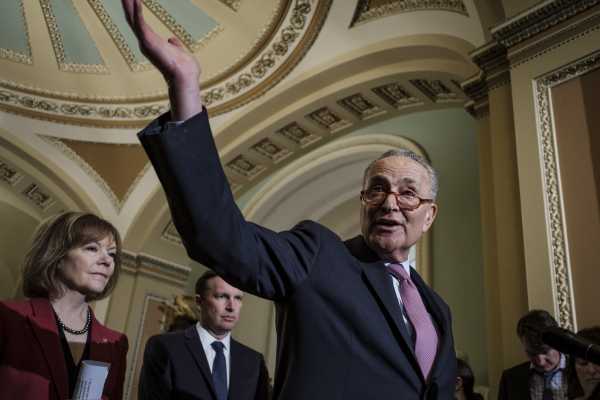
“The variable that explains a lot of what we’re seeing is a party weakness to narrow out the field in this stage, but also to distribute the talent pool or behind-the-scenes persuade people that what they want to do is [run for the Senate],” Julia Azari, a political scientist with Marquette University and contributor to an independent blog on Vox, said.
It’s no secret that the Senate isn’t what it used to be, especially for the minority party. Former governors who have served as their state’s executives don’t feel like taking a back seat in the Senate, especially at this point in its history. “As an institution it’s pretty weak and dilapidated at this point,” said Josh Huder, a senior fellow at Georgetown University’s Government Affairs Institute.
After all, Majority Leader Mitch McConnell is openly bragging about the upper chamber being a legislative graveyard. Major pushes on legislation, from health care and immigration to even disaster aid and election security, have been stuck in a partisan stalemate. But this moment also says something about the strength of the party as a whole.
Democratic leaders are finding it hard to make the case that running for the Senate carries the same weight in the party.
“Running for the president is no longer running to be the leader of the party, it’s running to be yourself, and the party will follow you,” Wallner said. “For God’s sake, look at Donald Trump. He wasn’t even a Republican, and now he is the Republican Party.”
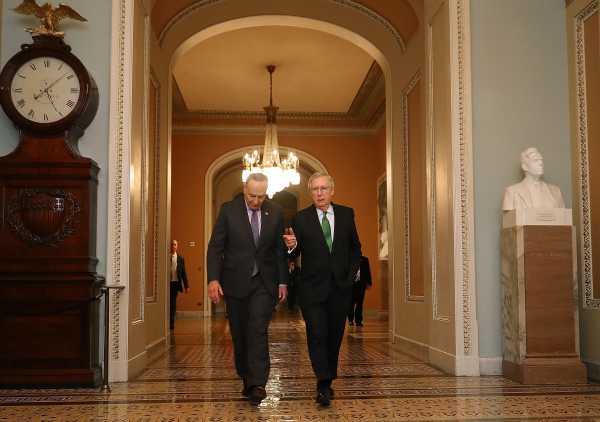
Correction: A previous version of this article said Maine is the only state Clinton won in 2016 with a Republican-held Senate seat up this year. Clinton also won Colorado in 2016. We regret the error.
Sourse: vox.com






